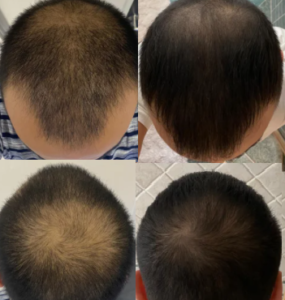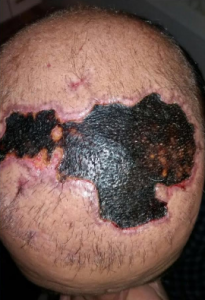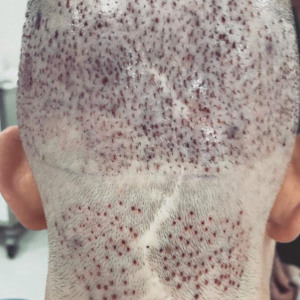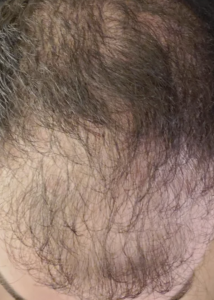You can never be absolute with such a statement. Everyone is different. If there were no side effects from finasteride and you were balding, then yes, you would be better on it to slow down the coarse of hair loss which is the benefit for all men taking this drug, one way or another. If you don’t get side effect, the drug can, in the long term, also reduce your risk for prostate cancer in your senior years if you continue to take the drug throughout your life.
https://www.ncbi.nlm.nih.gov/pmc/articles/PMC4314881/
This article concludes: Topical finasteride can be considered for hair density maintenance after initial improvement with oral finasteride, thereby obviating the indefinite use of oral finasteride.
We are seeing more and more of these types of complications from hair transplant being done all over the world. There is no substitute for skill and experience. What should be a safe procedure is turning out very risky for some people as shown here. This will require skilled wound care, possibly for months and the patient will be left with a terrible scar. He could die from such a wound if the infection gets out of control. A high price to pay for a cheap hair transplant.
I’m 24 and I can’t live with this anymore. What can I do short of a hair transplant?
You have what is called a Class 4A pattern of balding with a suggestion that it may progress back to the crown area in time. There is still considerable frontal hair present in the balding front, so maybe this will respond to either Minoxidil or Peppermint Oil, or the drug finasteride avoiding a surgery for the moment or even adding miconeedling which has been shown to work well in young men. If this doesn’t work, a hair transplant would work but you should find a good doctor and develop a Master Plan (https://baldingblog.com/need-master-plan-think-hair-transplants-photos/) to assure yourself that you will always have hair as you get older.
Q1: I read a research paper citing that the peppermint oil is better than minoxidil. What are your thoughts? I have been using minoxidil for last 3-4 years, is it worth to switch to peppermint oil?
Q2: I reduced finasteride dosage to 0.63 mg from 1.25 mg 2 years ago, but after experiencing frontal hair loss increased it to 1 mg. Would hair grow back? Are there any other treatments available for frontal hair loss?
The December 2014 article: https://www.ncbi.nlm.nih.gov/pmc/articles/PMC4289931/ suggests that Peppermint Oil is better than minoxidil for promoting hair growth. I just had a patient tell me that they tried it and found that the minoxidil worked better for him.
I don’t have any independent opinion but did find the article of great interest and compelling. People who either reduce or stop finasteride and then return to the finasteride normal dose, sometimes do not get back to their earlier hair status.
Thank you for all of the advice you continue to give to the hair loss community! I frequently read the “Balding Blog” published on your website and appreciate the wealth of information it provides. On your blog, you have described some of the diagnostic procedures that you use to formulate a diagnosis. I notice that you have mentioned using instruments such as microscopes and the “HAIRCHECK” device. Are these types of instruments common in a dermatologists office? The reason I ask is because I have seen two dermatologists in the past two years for my own hair loss and they did not mention these types of things at all. The doctors I have seen seemed fairly dismissive about my condition and came to a diagnosis without even examining my hair. With all due respect to them, I do not feel that they truly considered all the factors of my hair loss situation to come to the most accurate diagnosis possible. I am considering scheduling another dermatology appointment with a doctor in my area but is it common practice for your neighborhood dermatologist to use more advanced diagnostic techniques (microscope, HAIRCHECK instrument, etc) or would I be better suited off going to a doctor who primarily focuses on hair loss/hair transplants? I would love to come to your office for a consultation with you but unfortunately I live in Pennsylvania so going to Los Angeles would be quite a trek! Is there anyone you would recommend for a hair loss consultation that uses some advanced diagnostic procedures on the NYC – Washington DC corridor or even as far west as Pittsburgh, Cleveland, or Chicago? Thank you for your help!
Unfortunately, many dermatologists are just not interested in genetic balding in men because there is little they can do about it other than prescribe finasteride and/or minoxidil. Finding a doctor who is committed to managing men like you is critical. Dr. Robert Bernstein in New York is one of them (along with his partner) who can give you a good assessment of your hair loss situation. For some reason I don’t understand, many doctors don’t offer the HAIRCHECK instrument test (https://baldingblog.com/haircheck-test-how-it-is-done-video/) which I personally believe is critical to early diagnosis. A discount flight to Los Angeles is not so bad considering that I offer a free initial consultation for people like you. Another good doctor is Dr. Robert Haber from Cleveland, Dr. Harris from Denver, Dr. Shapiro from Minniapolis, Dr. Konoir from Chicago and Dr. Brad Wolf from Cincinnati. I don’t know if they offer the HAIRCHECK test. I asked the company that makes the instrument to give me a list of doctors who have it so I can then give it to people like you. As of now, they are slow to respond.
I wanted to ask you with regards to Finasteride. My GP recommended that I can crush my 5mg Proscar pill into a fine powder, dissolve 1/5ths of the powder in water and then drink the solution. I was wondering what your take is on that, and if that’s a recommended alternative to splitting the 5mg Proscar pill (cutting the pill is something that I’ve had difficulties with).
Your doctor’s recommendation sounds fine. Be careful not to do it more than one pill at a time as the powder will pick up moisture out of the air. Be sure to keep the powder in a tight bottle.
If you are committed to stop the finasteride, just stop it. Sexual side effects may take up to a couple of months to go away.
https://pubmed.ncbi.nlm.nih.gov/32202088/#:~:text=Finasteride%20and%20dutasteride%20are%20frequently,and%20in%20men%20with%20AGA.&text=We%20suggest%20that%20long-term,disease%20and%20potential%20kidney%20disease
https://www.ncbi.nlm.nih.gov/pmc/articles/PMC4701851/
You can either (1) try a laser hair removal which may take a few sessions and runs the risk of depigmenting your skin if it is tan or dark (2) removing them with FUE directly which works well. I would love to see photos of what you don’t like, what was done wrong and if it could be fixed
I’m trying to fix the right temple hair above my eyebrow, instead of going up straight it curves 2 inches back messing up my line and making a triangle at the right? Should I go with FUT or FUE, I don’t care if it’s uneven or not because I can simply get my barber to match my left side after my right side has been fixed. Is Saw Palmetto better than nothing? I know it’s not fin or duasteride but I’m trying to block dht, I’m planning to use either Kirkland or Rogaine
Saw palmetto will not work as it is a very, very weak DHT blocker. A hair transplant can balance the hairlines but you should be over 25 before considering it or you might start getting a hair transplant every year as you chase an accelerated hair loss. Make sure that you get a Master Plan with a good, caring, honest doctor
If those hairs which are short hairs do not grow, then these hairs may eventually fall out. You might be developing a mature hairline. In advanced miniaturization, the hairs stop growing before the fall out. The use of finasteride with or without minoxidil might reverse it. Many young men will add microneedling to it as well
Men think that balding is a male problem, but women have it too and it is even more devastating when they are young and they often feel that they are looking old as a result of it. Believe it or not, almost 50% of women who go through menopause develop generalized thinning and often force them to make lifestyle adjustments. If you don’t believe it, look to your mom, aunts and grandmothers and many of you will see a ‘see-through scalp’. Post menopausal women get their genes for hair loss and express the balding when they lose their estrogen support at menopause. Then, without adequate amounts of estrogen, their androgens (e.g. testosterone) has no counter balance, so the genes for hair loss express themselves without estrogen protection. Many women go to the beauty parlor and dye their hair blonde or lighten their hair color to reduce the color/contrast between their skin and hair color making the thinning less obvious. We offer Scalp Micropigmentation for many of these women (see here: https://scalpmicropigmentation.com/).
Some young women also have genetic hair loss and it can express itself in two manners (1) by recession like a man can have where the hairline goes up or with a slightly different type of hair thinning pattern and (2) generalized thinning impacting the hair everywhere on their head. When recession occurs, a hair transplant can work well, but when generalized thinning occurs, we often just do Scalp Micropigmentation for them (see 33 year old female with photo here: https://baldingblog.com/i-am-a-33-year-old-famale-can-anyone-help-me-photo/). Some women will respond to finasteride (less than 50% for post menopausal women and even less for pre-menopausal women who must be very careful not to get pregnant because pregnancy and finasteride causes birth defects in the baby).
Women have hair loss from many causes including: Birth Control pills, all sorts of medications, thyroid, anemia, low Vitamin D levels, low Zinc Levels, and other endocrine problems. I often order a battery of blood tests for women (https://baldingblog.com/common-blood-tests-for-female-hair-loss/) when they come to me for evaluation to see if there is something wrong that should be fixed first.
Women have other problems including a variety of autoimmune diseases of the scalp (frontal fibrosing alopecia, Lichen Pilanoplaris, scarring alopecias from other causes) so women should see a good dermatologist to make sure that these diseases are not present. Getting a hair transplant while these diseases are present will fail.
Page 148 of 1234






